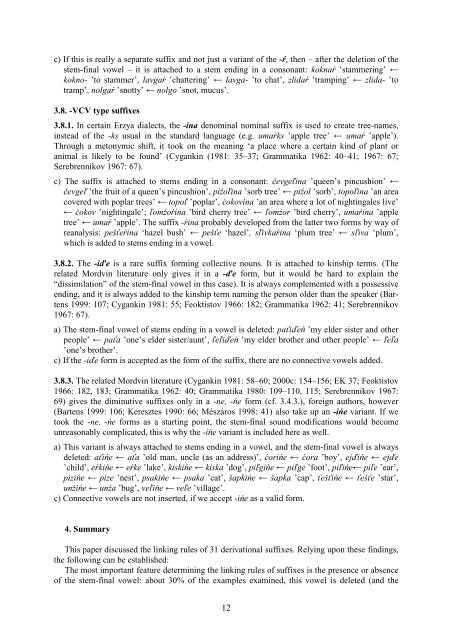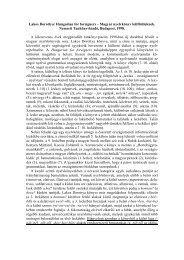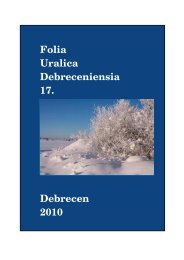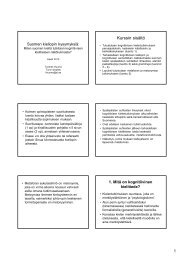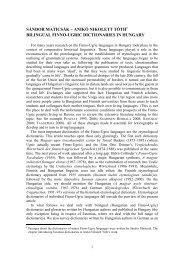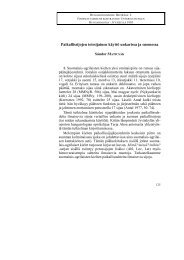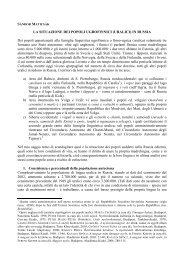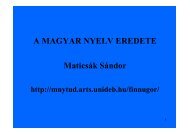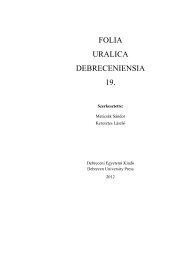Allomorphic variants of Erzya-Mordvin nominal derivational suffixes
Allomorphic variants of Erzya-Mordvin nominal derivational suffixes
Allomorphic variants of Erzya-Mordvin nominal derivational suffixes
Create successful ePaper yourself
Turn your PDF publications into a flip-book with our unique Google optimized e-Paper software.
c) If this is really a separate suffix and not just a variant <strong>of</strong> the -ŕ, then – after the deletion <strong>of</strong> thestem-final vowel – it is attached to a stem ending in a consonant: koknaŕ ’stammering’ ←kokno- ’to stammer’, lavgaŕ ’chattering’ ← lavga- ’to chat’, zlidaŕ ’tramping’ ← zlida- ’totramp’, nolgaŕ ’snotty’ ← nolgo ’snot, mucus’.3.8. -VCV type <strong>suffixes</strong>3.8.1. In certain <strong>Erzya</strong> dialects, the -ina de<strong>nominal</strong> <strong>nominal</strong> suffix is used to create tree-names,instead <strong>of</strong> the -ks usual in the standard language (e.g. umaŕks ’apple tree’ ← umaŕ ’apple’).Through a metonymic shift, it took on the meaning ‘a place where a certain kind <strong>of</strong> plant oranimal is likely to be found’ (Cygankin (1981: 35–37; Grammatika 1962: 40–41; 1967: 67;Serebrennikov 1967: 67).c) The suffix is attached to stems ending in a consonant: čevgeľina ’queen’s pincushion’ ←čevgeľ ’the fruit <strong>of</strong> a queen’s pincushion’, piźoľina ’sorb tree’ ← piźol ’sorb’, topoľina ’an areacovered with poplar trees’ ← topoľ ’poplar’, ćokovina ’an area where a lot <strong>of</strong> nightingales live’← ćokov ’nightingale’; ľomźoŕina ’bird cherry tree’ ← ľomźor ’bird cherry’, umaŕina ’appletree’ ← umaŕ ’apple’. The suffix -ŕina probably developed from the latter two forms by way <strong>of</strong>reanalysis: pešťeŕina ‘hazel bush’ ← pešťe ‘hazel’, sľivkaŕina ‘plum tree’ ← sľiva ‘plum’,which is added to stems ending in a vowel.3.8.2. The -iďe is a rare suffix forming collective nouns. It is attached to kinship terms. (Therelated <strong>Mordvin</strong> literature only gives it in a -ďe form, but it would be hard to explain the“dissimilation” <strong>of</strong> the stem-final vowel in this case). It is always complemented with a possessiveending, and it is always added to the kinship term naming the person older than the speaker (Bartens1999: 107; Cygankin 1981: 55; Feoktistov 1966: 182; Grammatika 1962: 41; Serebrennikov1967: 67).a) The stem-final vowel <strong>of</strong> stems ending in a vowel is deleted: paťiďeń ’my elder sister and otherpeople’ ← paťa ’one’s elder sister/aunt’, ľeľiďeń ’my elder brother and other people’ ← ľeľa’one’s brother’.c) If the -iďe form is accepted as the form <strong>of</strong> the suffix, there are no connective vowels added.3.8.3. The related <strong>Mordvin</strong> literature (Cygankin 1981: 58–60; 2000c: 154–156; EK 37; Feoktistov1966: 182, 183; Grammatika 1962: 40; Grammatika 1980: 109–110, 115; Serebrennikov 1967:69) gives the diminutive <strong>suffixes</strong> only in a -ne, -ńe form (cf. 3.4.3.), foreign authors, however(Bartens 1999: 106; Keresztes 1990: 66; Mészáros 1998: 41) also take up an -ińe variant. If wetook the -ne, -ńe forms as a starting point, the stem-final sound modifications would becomeunreasonably complicated, this is why the -ińe variant is included here as well.a) This variant is always attached to stems ending in a vowel, and the stem-final vowel is alwaysdeleted: aťińe ← aťa ’old man, uncle (as an address)’, ćorińe ← ćora ’boy’, ejďińe ← ejďe’child’, eŕkińe ← eŕke ’lake’, kiskińe ← kiska ’dog’, piľgińe ← piľge ’foot’, piľińe← piľe ’ear’,pizińe ← pize ’nest’, psakińe ← psaka ’cat’, šapkińe ← šapka ’cap’, ťešťińe ← ťešťe ’star’,unžińe ← unža ’bug’, veľińe ← veľe ’village’.c) Connective vowels are not inserted, if we accept -ińe as a valid form.4. SummaryThis paper discussed the linking rules <strong>of</strong> 31 <strong>derivational</strong> <strong>suffixes</strong>. Relying upon these findings,the following can be established:The most important feature determining the linking rules <strong>of</strong> <strong>suffixes</strong> is the presence or absence<strong>of</strong> the stem-final vowel: about 30% <strong>of</strong> the examples examined, this vowel is deleted (and the12


